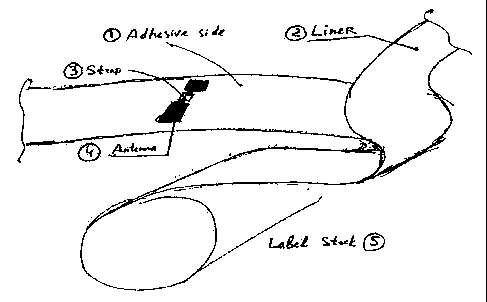Some of the information on this Web page has been provided by external sources. The Government of Canada is not responsible for the accuracy, reliability or currency of the information supplied by external sources. Users wishing to rely upon this information should consult directly with the source of the information. Content provided by external sources is not subject to official languages, privacy and accessibility requirements.
Any discrepancies in the text and image of the Claims and Abstract are due to differing posting times. Text of the Claims and Abstract are posted:
| (12) Patent Application: | (11) CA 2528797 |
|---|---|
| (54) English Title: | RFID TRANSPONDER STRUCTURE OPTIMIZED FOR IN-LINE LABEL CONSTRUCTION |
| (54) French Title: | STRUCTURE DE REPONDEUR D'IDENTIFICATION PAR RADIOFREQUENCE, OPTIMISEE POUR LA CREATION D'ETIQUETTES EN LIGNE |
| Status: | Deemed Abandoned and Beyond the Period of Reinstatement - Pending Response to Notice of Disregarded Communication |
| (51) International Patent Classification (IPC): |
|
|---|---|
| (72) Inventors : |
|
| (73) Owners : |
|
| (71) Applicants : |
|
| (74) Agent: | MACRAE & CO. |
| (74) Associate agent: | |
| (45) Issued: | |
| (22) Filed Date: | 2005-12-01 |
| (41) Open to Public Inspection: | 2007-06-01 |
| Availability of licence: | N/A |
| Dedicated to the Public: | N/A |
| (25) Language of filing: | English |
| Patent Cooperation Treaty (PCT): | No |
|---|
| (30) Application Priority Data: | None |
|---|
The invention provides a method of manufacturing RFID transponders for
attachment to packages that will be in transit or to packages containing, for
example, medicinal preparations, when information respecting the handling of
the
packages or the timing of removal of the medicinal preparations is required.
The
method utilizes a continuous strip of adhesive backed material, such as an
adhesive
tape supplied on a roll. As the tape is removed from the roll an anti-adhesive
material is applied to predetermined areas of the adhesive surface to render
such
areas non-adhesive. A conductive ink is coated to the non-adhesive areas to
create
spaced apart antenna pads. An RFID chip strap, carrying an RFID chip, and
having
corresponding spaced apart conductive pads is applied to the tape with the
conductive pads thereof contacting the antenna pads. The strap is secured to
the
tape through contact with the adhesive surrounding the antenna pads. Completed
transponders can be severed from the tape and applied via the adhesive thereon
to
the package as desired.
Note: Claims are shown in the official language in which they were submitted.
Note: Descriptions are shown in the official language in which they were submitted.

2024-08-01:As part of the Next Generation Patents (NGP) transition, the Canadian Patents Database (CPD) now contains a more detailed Event History, which replicates the Event Log of our new back-office solution.
Please note that "Inactive:" events refers to events no longer in use in our new back-office solution.
For a clearer understanding of the status of the application/patent presented on this page, the site Disclaimer , as well as the definitions for Patent , Event History , Maintenance Fee and Payment History should be consulted.
| Description | Date |
|---|---|
| Application Not Reinstated by Deadline | 2010-12-01 |
| Time Limit for Reversal Expired | 2010-12-01 |
| Deemed Abandoned - Failure to Respond to Maintenance Fee Notice | 2009-12-01 |
| Letter Sent | 2008-03-19 |
| Inactive: Transfer reinstatement | 2008-02-12 |
| Reinstatement Requirements Deemed Compliant for All Abandonment Reasons | 2008-02-12 |
| Inactive: Declaration of entitlement - Formalities | 2008-02-12 |
| Inactive: Status info is complete as of Log entry date | 2007-06-05 |
| Application Published (Open to Public Inspection) | 2007-06-01 |
| Inactive: Cover page published | 2007-05-31 |
| Inactive: Abandoned - No reply to Office letter | 2007-03-05 |
| Inactive: Filing certificate - No RFE (English) | 2006-11-15 |
| Correct Inventor Requirements Determined Compliant | 2006-11-15 |
| Inactive: First IPC assigned | 2006-08-31 |
| Inactive: IPC assigned | 2006-08-31 |
| Inactive: Filing certificate correction | 2006-02-10 |
| Inactive: Courtesy letter - Evidence | 2006-01-24 |
| Filing Requirements Determined Compliant | 2006-01-19 |
| Inactive: Filing certificate - No RFE (English) | 2006-01-19 |
| Application Received - Regular National | 2006-01-17 |
| Small Entity Declaration Determined Compliant | 2005-12-01 |
| Abandonment Date | Reason | Reinstatement Date |
|---|---|---|
| 2009-12-01 |
The last payment was received on 2008-10-31
Note : If the full payment has not been received on or before the date indicated, a further fee may be required which may be one of the following
Please refer to the CIPO Patent Fees web page to see all current fee amounts.
| Fee Type | Anniversary Year | Due Date | Paid Date |
|---|---|---|---|
| Application fee - small | 2005-12-01 | ||
| MF (application, 2nd anniv.) - small | 02 | 2007-12-03 | 2007-12-03 |
| Reinstatement | 2008-02-12 | ||
| MF (application, 3rd anniv.) - small | 03 | 2008-12-01 | 2008-10-31 |
Note: Records showing the ownership history in alphabetical order.
| Current Owners on Record |
|---|
| INTELLIGENT DEVICES INC. |
| Past Owners on Record |
|---|
| JAMES NEILSON |
| MICHAEL PETERSEN |
| MYKOLA SHERSTYUK |